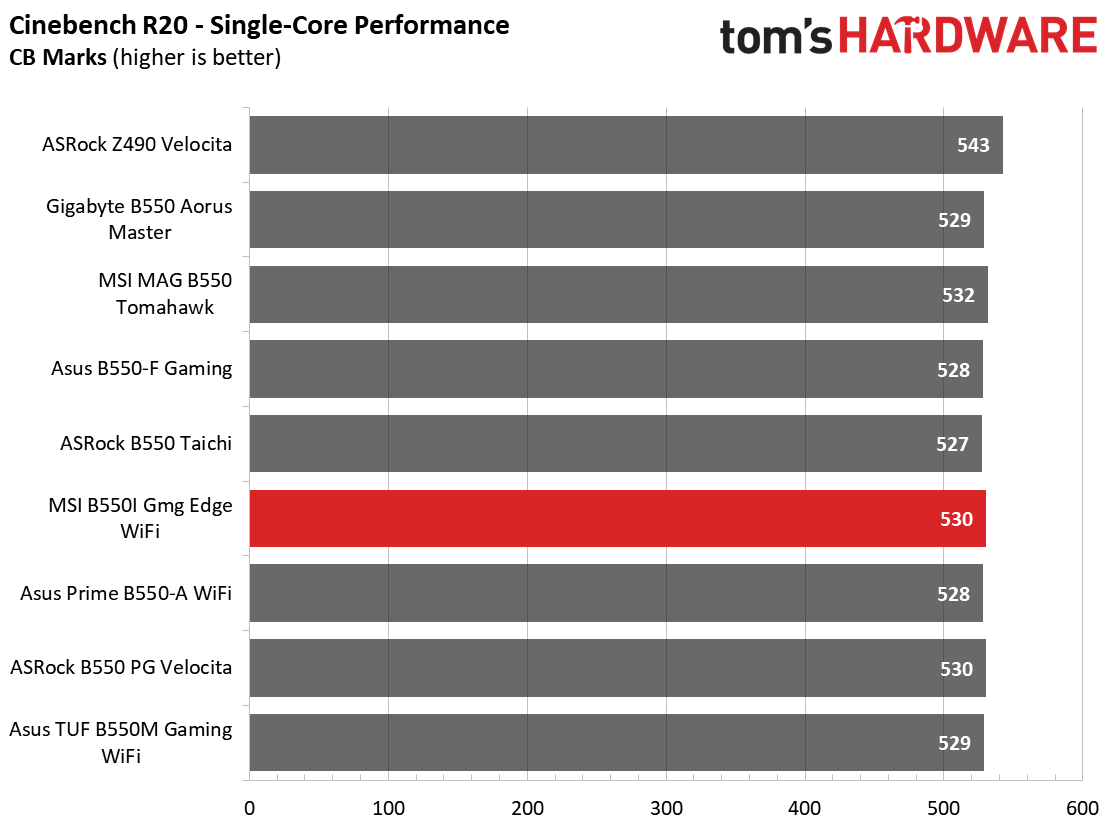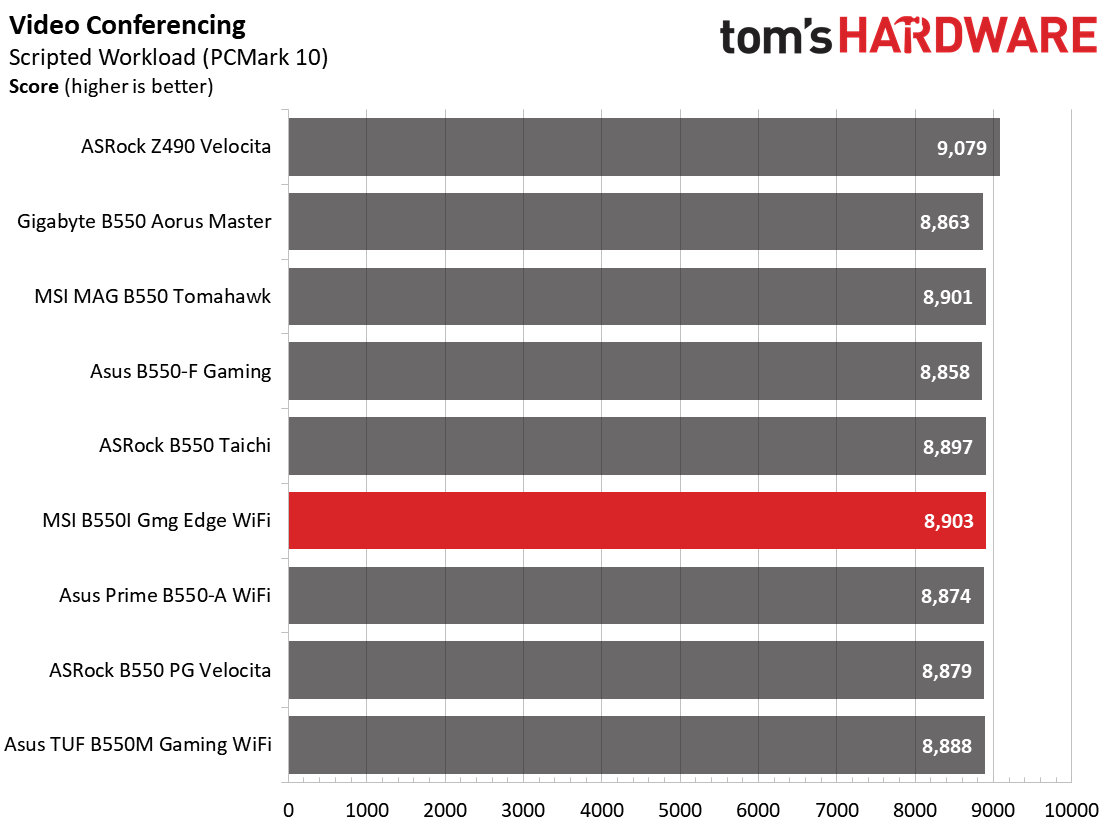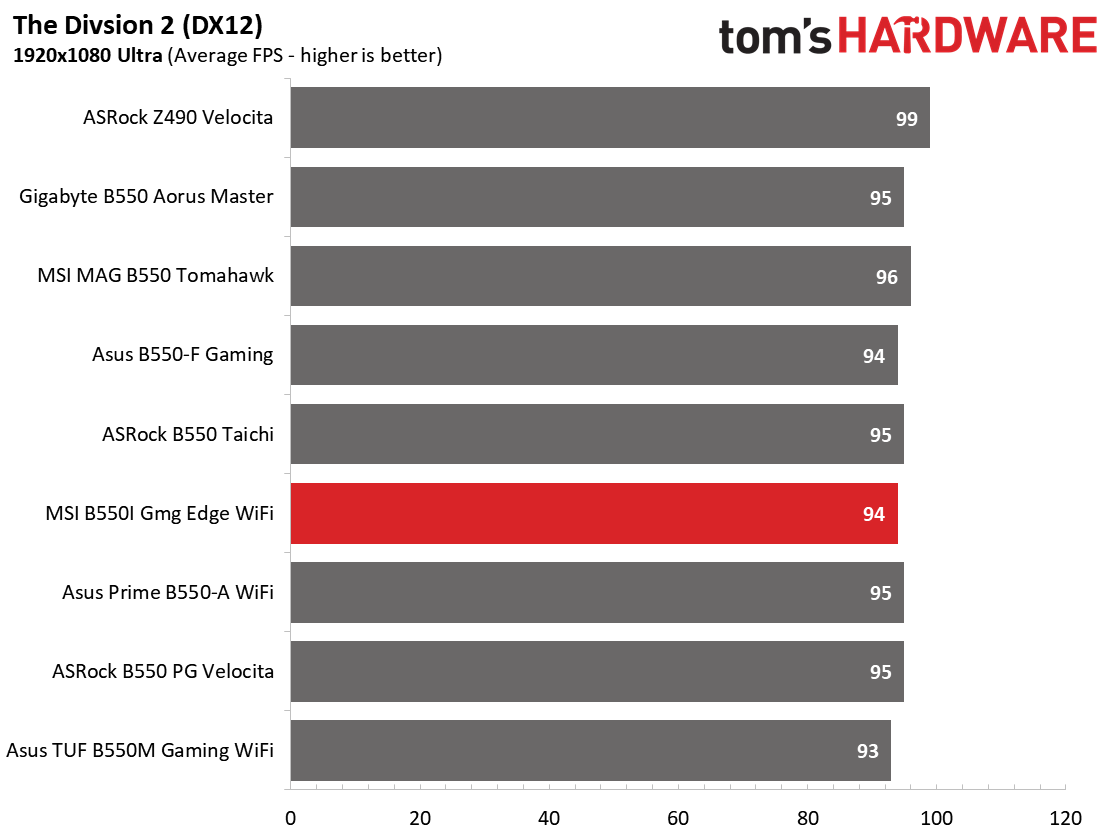Why you can trust Tom's Hardware
Our standard benchmarks and power tests are performed using the CPU’s stock frequencies (including stock Thermal Velocity Boost), with all power-saving features enabled. Optimized defaults get set in the BIOS and the memory uses its XMP profiles. For this baseline testing, we set Windows to High Performance, except for power testing that uses the Balanced plan for the PC to reach an idle state.
Synthetic Benchmarks
Synthetic benchmarks are a great tool to figure out if a board is running out of spec, as identical settings should produce similar performance results. Advanced memory timings are the one place where motherboard makers can still optimize for either stability or performance, though, and those settings can impact some testing.





















In our synthetic benchmarks, the B550I Gaming Edge Wi-Fi’s results were right in line with the other, ATX B550 motherboards we’ve tested. We haven’t seen a lot of deviation in most of these tests, except perhaps with the PCMark suite which can be a bit temperamental at times.
Timed Applications




In our timed application tests, LAME and Handbrake, the Gaming Edge Wi-Fi’s times we spot on against the other B550 motherboards.
3D Games and 3DMark




We’ve recently updated our game tests to The Division 2 and Forza Horizon 4. The games are run at 1920x1080 resolution using the Ultra preset. As the resolution goes up, the CPU tends to have less of an impact and most games at this resolution in the first place. The goal with these settings is to determine if there are differences in performance at the most commonly used resolution with settings most people use or at least strive for.
During our gaming and 3DMark tests, MSI’s Mini ITX board kept up with all other B550-based products without issue. 3DMark Fire Strike, Time Spy, and our two games continue to show very little difference with all boards, within a small margin-of-error range.
Power Consumption and VRM Temperatures
For power testing, we use AIDA64’s System Stability Test with Stress CPU, FPU and Cache enabled, using the peak power consumption value. The wattage reading comes from the wall via a Kill-A-Watt meter to capture the entire ecosystem. The only variable that changes is the motherboard; all other parts are the same.
Get Tom's Hardware's best news and in-depth reviews, straight to your inbox.
When our system was at idle (using the AMD Balanced power plan in Windows), the Gaming Edge Wi-Fi pulled 47W from the wall, a value tied for the lowest idle wattage we’ve seen so far. After applying the AIDA64 stress test load, power use peaked at 216W from the wall, leaning towards the higher end of consumption.




Our B550 Gaming Edge Wi-Fi and its 8-phase (Vcore) 60A VRMs handled both stock and overclocked testing without issue. During the stock runs, the hottest point on the VRM peaked just under 50 degrees Celsius (Hwinfo didn’t display a MOS sensor). After overclocking to 4.3 GHz and 1.35V, temperatures increased a few degrees and peaked at 56 degrees Celsius, well within the operational parameters of the MOSFETs.
Note that the dip on the chart around the 18-minute mark was from the chassis fan falling on the VRMs for a brief time, not any throttling.
Overclocking
There are several ways to overclock on AMD platforms, depending on your goals. If your focus is single-threaded performance, it’s best to tweak PBO and let the motherboard and CPU figure it out under the parameters entered. If you are looking for better multi-core/thread performance, you will overclock all cores to the same speed. Part of our goal is to test the capability of the motherboard, so we chose the more power-hungry option, 4.3 GHz and 1.35V for an all core/thread overclock. The Gaming Edge Wi-Fi handled our 12c/24t Ryzen 9 3900X overclock without issue. Vdroop was mitigated well by the default setting (auto); no other tweaks were necessary. We simply set the voltage to a static 1.35V and 43x CPU multiplier, then off we went to stability testing.
Final Thoughts
MSI’s B550I Gaming Edge Wi-Fi ($199.99) proved to be a competent performer in our stock benchmarks, as well as the overclocking we put it through. The power delivery, while not the most robust, handled our 12c/24t Ryzen 9 3900X with poise. Features-wise, the tiny board managed to stuff two M.2 slots, four SATA ports and a fair amount of USB ports on the rear IO (and headers). About the only thing missing is lighting. You’ll have to bring your own RGB via a header on the board.
At this price and form-factor, the B550I Gaming Edge’s direct competitors are the Gigabyte B550I Aorus Pro AX ($179.99), ASRock B550 Phantom Gaming-ITX/ax ($199.99) and the Asus ROG Strix B550-I Gaming ($229.99). The most significant difference between these boards outside of price is the VRM capability (the other boards have better power delivery), audio (not that many would notice a difference), officially supported memory speeds and aesthetics/integrated RGB lighting (ASRock and Gigabyte integrate the LEDs).
Without getting our hands on the other Mini ITX size boards (yet), it’s tough to declare an outright winner among these diminutive B550 based motherboards. For just under $200, the MSI B550I Gaming Edge Wi-Fi showed that it is more than capable of handling our Ryzen 9 3900X, even when overclocked. Suppose you are looking for a Mini ITX size motherboard and want to save some money by going to B550 chipset. In that case, the MSI MPG B550I Gaming Edge Wi-Fi is a viable option to build your system around, though if you crave that RGB lighting and better power delivery, there are other options available. Some are even priced less.
MORE: Best Motherboards
MORE: How To Choose A Motherboard
MORE: All Motherboard Content

Joe Shields is a staff writer at Tom’s Hardware. He reviews motherboards and PC components.
-
LaminarFlow A rating of 3.5/5 seems harsh, since for many people (myself included), having not RGB is a plus.Reply
I bought this board over the Gigabyte Aorus ITX for precisely one reason: USB type C header. Compare with ASRock and Asus ones, this board is cheaper with no sacrifice.
Having said all this, a common complain people have with this board is its cpu back plate. It's not a problem for me since I'm using it with an AIO (NXZT H1), but it won't fit many others that require installation of custom back plate. -
Meru Otonashi Definitely an issue, I was almost tempted to start shopping for this until I saw that the configuration will not fit the Noctua NH-L9a-AM4 backplate because of the chips.Reply
People had to resort to cutting down the backplate with a dremel to fit. Definitely not great. -
mrv_co ReplyLaminarFlow said:A rating of 3.5/5 seems harsh, since for many people (myself included), having not RGB is a plus.
I bought this board over the Gigabyte Aorus ITX for precisely one reason: USB type C header. Compare with ASRock and Asus ones, this board is cheaper with no sacrifice.
Having said all this, a common complain people have with this board is its cpu back plate. It's not a problem for me since I'm using it with an AIO (NXZT H1), but it won't fit many others that require installation of custom back plate.
The lack of RGB should add one full star to the rating. -
Kíbin Its also the only motherboard that "officially" supports AMD Ryzen Pro features, such as RAM and Storage encryption.Reply

